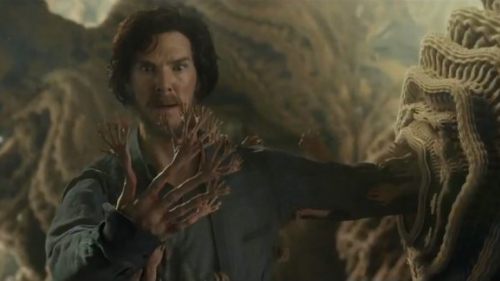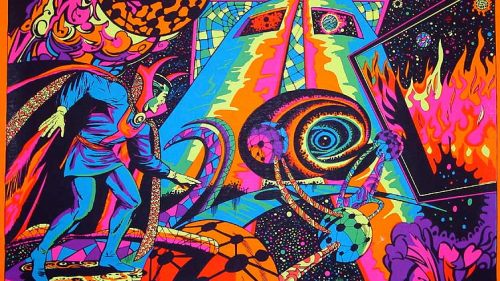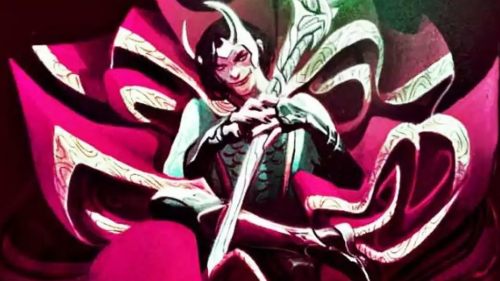TRIUMPH AND TORMENT: Doctor Strange Goes To Hell
We are celebrating this week's Doctor Strange release (get your tickets here!) with a bunch of articles all dedicated to Marvel's Sorcerer Supreme.
“The mind transcends all,” the Aged Genghis instructs one of his acolytes in the foothills of the Himalayas, prefacing a series of illustrated images spanning the globe: from the Mayan ruins of Yucatan, to the island of Honshu, the moors of Great Britain, the blue of sunken Atlantis. And then two robed figures: one in the tiny Balkan state of Latveria straining to listen, the other hovering above his bed in his Sanctum Sanctorum in Greenwich Village. They’ve all heard the call of Genghis, who has summoned them to the Temple of the Three where the world’s greatest mystics meet once every century to determine and acknowledge a Sorcerer Supreme. So begins Roger Stern’s and Mike Mignola’s Doctor Strange & Doctor Doom: Triumph and Torment, a quest narrative about a superhero and supervillain working together to save one woman’s soul from hell, one of the greatest stories ever written about these characters.
Since Steve Ditko created him in 1963, Doctor Stephen Strange has encountered Dracula, Dormammu, Eternity, Nightmare, D’Spayre, Death, ancient Lovecraftian gods, and an evil wizard masquerading as Benjamin Franklin. He’s journeyed to the Old West, Transylvania, a living planet, the Dark Realm, a void between time, even the dawn of creation. And despite being one of the most well-traveled and compelling characters in the Marvel universe, he hasn’t always been the most popular, or the easiest to write. Doctor Strange was once a self-proclaimed “decadent and degraded” surgeon until his career ended when his hands were burned in a car crash. He wandered the globe searching for a cure until he found the Ancient One who instructed him in the mystic arts, and this is when Doctor Strange becomes more of a healer than he ever was as a surgeon.
Doctor Strange stands apart from superheroes like Spider-Man in that he doesn’t appear relatable, at least not at first glance — many of us have been young awkward nerds, but none of us has been a Sorcerer Supreme. He is Earth’s psychedelic protector, a supernatural problem-solver, his foes too weird for other superheroes. His storylines don’t endlessly retread his hero’s journey — since his initial transformation from an expert surgeon to a master of mysticism, self-sacrifice and heroism comes naturally to him.
But even Doctor Strange struggles with a moral dilemma in Triumph and Torment. The story’s first half is easier for him: the Aged Genghis and three magical god-like beings called the Vishanti have concocted the challenge for the sorcerers who’ve gathered at the Temple of the Three. They must save the Aged Genghis from the Vishanti’s enchantments, which traps him in a seemingly impenetrable crystal guarded by their powerful magic. Of course it’s Doctor Strange who saves the Aged Genghis, and Doctor Doom is the only other sorcerer left standing alongside him. As the winner of the challenge, Doctor Strange must grant Doctor Doom a boon since he alone evaded the power of the Vishanti’s crystal. Strange hesitates because Doom is a “ruthless dictator,” though he’s duty-bound to help him. But Doom’s request is not nefarious: Doom seeks Strange’s assistance and expertise to rescue the damned soul of his mother Cynthia Von Doom from Mephisto in Hades. The tale takes a poignant turn as it becomes something operatic, beautiful, Faustian. Doctor Doom even sheds a tear.
Doom and Strange enter Hades and explore the surreality beyond reality together. Hell is an ever-shifting landscape, both are brought to the depths of despair by Mephisto-induced hallucinations, and they place absolute trust in each other. Doom owns this story — it’s maybe more his than Strange’s. Strange has already proven time and again that he’s a good man, but Doom surprises us by being human at all. The beauty of Triumph and Torment is in their partnership, and the comic ends with lines from a poem by Stanley Kunitz: “I stand on the terrible threshold, and I see the end and the beginning in each other’s arms.” Triumph and Torment reveals Doom’s humanity, and Strange’s compassion that allows him to recognize this humanity.
Stephen Strange is willing to brave the depths of hell if that’s what his task requires — if that’s what it takes for him to help another living being, even a villain like Doctor Doom. In Steve Engelhart’s, Mike Friedrich’s, and Frank Brunner’s Marvel Premiere #12 from 1973, Doctor Strange journeyed to the Mexican desert, explaining to his disciple Clea: “I came to delve into my soul [ . . . ] to weigh the intangibles that truly compose my being, and determine whether I am pleased with the balance.” And Doctor Strange is about harmony, about the occult saying “as above, so below,” meaning the microcosm and the macrocosm are one and the same. The mind is as strange and boundless a place to explore as the cosmos, and fighting other-dimensional entities is not so different from grappling with real despair, fear, and nightmares within us. Triumph and Torment, ultimately, is a story about the sacrifices we are willing to make for others, the good that we can do for loved ones and strangers alike. This is the best of Doctor Strange: a man seeking to heal and restore harmony to the universe itself and those who occupy it.
In Steve Engelhart’s and Frank Brunner’s Doctor Strange run from the early ‘70s, magic is a limited resource, and a sorcerer from the future named Sise-Neg wants to become god by absorbing all the world’s magic when he returns to the dawn of creation. Doctor Strange and his nemesis Baron Mordo join Sise-Neg as he time-travels backward: Strange trying to stop him, Mordo hoping to gain his favor. Sise-Neg succeeds, but he has an epiphany — in achieving godhood, he learns the truth that “everything is as it should be,” and that “man is imperfect — but he is this dimension’s closest approximation of perfection.” Sise-Neg chooses to recreate the universe exactly as it was before. His realization is reflected in something else Doctor Strange explains in Marvel Premiere #12, his philosophy and statement of purpose: “The cosmos is everything! To affect any part of the cosmos is to affect the totality! Life is the most precious gift the cosmos can bestow… and it is the lot of Doctor Strange to preserve the gift.”



